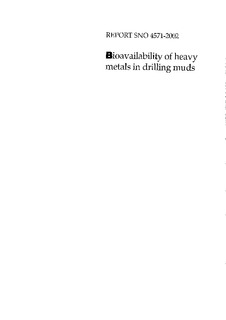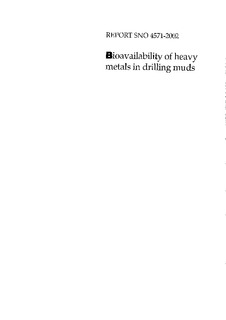| dc.contributor.author | Schaanning, M. | nb_NO |
| dc.contributor.author | Ruus, A. | nb_NO |
| dc.contributor.author | Bakke, T. | nb_NO |
| dc.contributor.author | Hylland, Ketil | nb_NO |
| dc.contributor.author | Olsgard, Frode | nb_NO |
| dc.contributor.other | Schaanning, M. - Project manager | nb_NO |
| dc.date.accessioned | 2014-08-01T10:47:27Z | |
| dc.date.available | 2014-08-01T10:47:27Z | |
| dc.date.issued | 2002 | nb_NO |
| dc.identifier | 4571 | nb_NO |
| dc.identifier.isbn | 82-577-4229-5 | nb_NO |
| dc.identifier.issn | 1894-7948 | nb_NO |
| dc.identifier.uri | http://hdl.handle.net/11250/211815 | |
| dc.description.abstract | Experimental work on uptake of metals from sediments spiked with barite, ilmenite and hematite were performed using the ragworm Nereis diversicolor and the netted dog whelk Hinia (Nassarius) reticulata as test organisms. The present report also provides a brief review of recent litterature on biological effects of metals in drill cuttings, including relevant results from the UKOOA Drill Cuttings Initiative - an international research programme completed in December 2001. The review suggest low to moderate bioaccumulation and toxicity of metals in drill cuttings to marine organisms. The experimental work was performed in a standard test set-up at Solbergstrand Marine Research Station. The test determines enrichment ratios in exposed vs control organisms. Ratios of 67 and 76 for the respective species showed significant uptake of barium from marine sediments spiked with barite. Similarly, significant uptake of titanium were observed in organisms exposed to ilmenite. All other elements (Al, Li, Fe, Zn, Hg, Cd, Pb, Cu, Cr and Ni) showed no significant uptake and ratios within the range 0,6-1,5. This result was partly explained by anomalous low concentrations of Pb in the barite test substance, partly by the presence in several test substances of major fractions of Cr, Ni, Zn and Cu insoluble in standard nitric acid digestion (NS4770). Toxic effects of metals strongly bound in particulate mineral fractions are not expected. | nb_NO |
| dc.description.sponsorship | Norbar Minerals AS | nb_NO |
| dc.publisher | Norsk institutt for vannforskning | nb_NO |
| dc.relation.ispartofseries | NIVA-rapport;4571 | nb_NO |
| dc.rights | Navngivelse-IkkeKommersiell-DelPåSammeVilkår 3.0 Norge | nb_NO |
| dc.rights.uri | http://creativecommons.org/licenses/by-nc-sa/3.0/no/ | nb_NO |
| dc.subject | micropollutants sea water | nb_NO |
| dc.title | Bioavailability of heavy metals in drilling muds | nb_NO |
| dc.type | Research report | nb_NO |
| dc.rights.holder | Norsk institutt for vannforskning/Norwegian institute for water research | nb_NO |
| dc.subject.nsi | VDP::Matematikk og naturvitenskap: 400 | nb_NO |
| dc.source.pagenumber | 31 | nb_NO |
| dc.subject.keyword | tungmetaller | nb_NO |
| dc.subject.keyword | boreslam | nb_NO |
| dc.subject.keyword | baritt | nb_NO |
| dc.subject.keyword | marine sedimenter | nb_NO |
| dc.subject.keyword | heavy metals | nb_NO |
| dc.subject.keyword | drilling mud | nb_NO |
| dc.subject.keyword | barite | nb_NO |
| dc.subject.keyword | marine sediments | nb_NO |
| dc.relation.project | 21337 | nb_NO |


